2019 NISSAN TITAN trans
[x] Cancel search: transPage 593 of 682
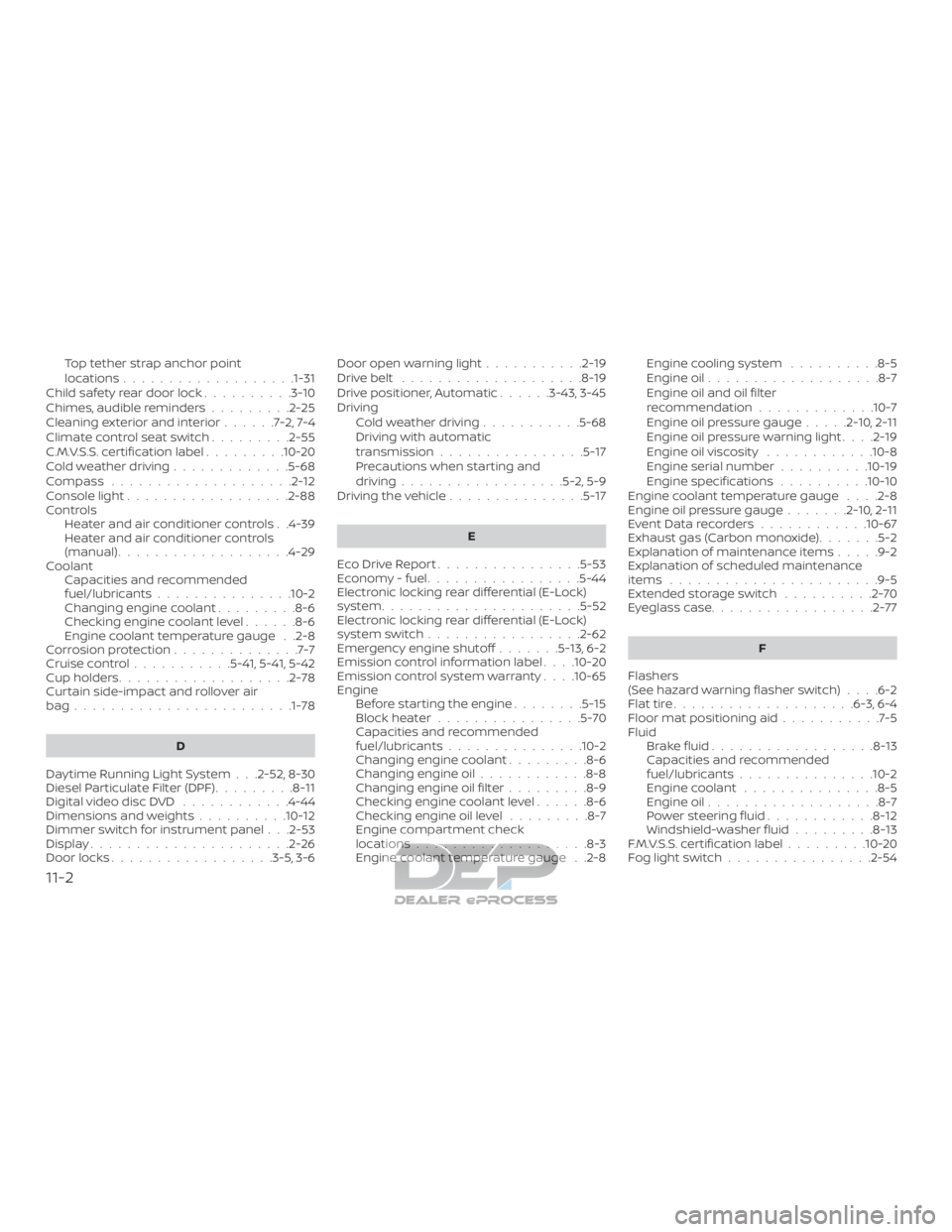
Top tether strap anchor point
locations...................1-31
Child safety rear door lock ..........3-10
Chimes, audible reminders .........2-25
Cleaningexteriorandinterior......7-2,7-4
Climatecontrolseatswitch.........2-55
C.M.V.S.S. certification label .........10-20
Coldweatherdriving.............5-68
Compass ....................2-12
Console light ..................2-88
Controls Heater and air conditioner controls . .4-39
Heater and air conditioner controls
(manual) ...................4-29
Coolant Capacities and recommended
fuel/lubricants...............10-2
Changing engine coolant .........8-6
Checking engine coolant level ......8-6
Engine coolant temperature gauge . .2-8
Corrosionprotection..............7-7
Cruisecontrol...........5-41,5-41,5-42
Cupholders...................2-78
Curtain side-impact and rollover air
bag........................1-78
D
Daytime Running Light System . . .2-52, 8-30
Diesel Particulate Filter (DPF) .........8-11
DigitalvideodiscDVD ............4-44
Dimensions and weights ..........10-12
Dimmer switch for instrument panel . . .2-53
Display......................2-26
Door locks ..................3-5,3-6 Door open warning light
...........2-19
Drivebelt ....................8-19
Drive positioner, Automatic ......3-43,3-45
Driving Cold weather driving ...........5-68
Driving with automatic
transmission ................5-17
Precautions when starting and
driving..................5-2,5-9
Drivingthevehicle...............5-17
E
Eco Drive Report ................5-53
Economy - fuel .................5-44
Electronic locking rear differential (E-Lock)
system ......................5-52
Electronic locking rear differential (E-Lock)
system switch .................2-62
Emergency engine shutoff .......5-13,6-2
Emission control information label . . . .10-20
Emission control system warranty . . . .10-65
Engine Before starting the engine ........5-15
Blockheater................5-70
Capacities and recommended
fuel/lubricants...............10-2
Changing engine coolant .........8-6
Changing engine oil ............8-8
Changing engine oil filter .........8-9
Checking engine coolant level ......8-6
Checking engine oil level .........8-7
Engine compartment check
locations...................8-3
Engine coolant temperature gauge . .2-8 Engine cooling system
..........8-5
Engine oil ...................8-7
Engine oil and oil filter
recommendation .............10-7
Engine oil pressure gauge .....2-10,2-11
Engine oil pressure warning light ....2-19
Engine oil viscosity ............10-8
Engine serial numbe r..........10-19
Engine specifications ..........10-10
Engine coolant temperature gauge ....2-8
Engine oil pressure gauge .......2-10,2-11
EventDatarecorders............10-67
Exhaust gas (Carbon monoxide) .......5-2
Explanation of maintenance items .....9-2
Explanation of scheduled maintenance
items .......................9-5
Extended storage switch ..........2-70
Eyeglasscase..................2-77
F
Flashers
(Seehazardwarningflasherswitch)....6-2
Flattire....................6-3,6-4
F lo
ormatpositioningaid...........7-5
Fluid Brakefluid..................8-13
Capacities and recommended
fuel/lubricants...............10-2
Engine coolant ...............8-5
Engine oil ...................8-7
Powersteeringfluid............8-12
Windshield-washer fluid .........8-13
F.M.V.S.S. certification label .........10-20
Foglightswitch................2-54
11-2
Page 594 of 682

Front air bag system
(See supplemental restraint
system)..................1-60, 1-75
Front and rear sonar system ........5-63
Front-door pocket ...............2-71
Front power seat adjustment ........1-5
Frontseats....................1-2
Fuel Capacities and recommended
fuel/lubricants...............10-2
Fuel economy ...............5-44
Fuel gauge ..................2-9
Fueloctanerating.............10-7
Fuel recommendation ..........10-5
Loose fuel cap warning .........2-40
Fuel Cell Vehicle (FCV) System Tire pressure ................8-35
Fuelefficientdrivingtips...........5-43
Fuel-filler door .................3-27
Fuel gauge ....................2-9
Fuses .......................8-23
Fusiblelinks...................8-25
G
Garage door opener, HomeLink® Universal
Transceiver . .2-89, 2-90, 2-91, 2-92, 2-92, 2-93
Gauge Automatic transmission fluid
temperature gauge ............2-10
Engine coolant temperature gauge . .2-8
Engine oil pressure gauge .....2-10,2-11
Fuel gauge ..................2-9
Odometer ..................2-7
Speedometer ................2-7 Tachometer
.................2-8
Trip odometer ................2-7
Voltmeter ..................2-11
General maintenance .............9-2
Glovebox....................2-75
Grocery hooks .................2-81
H
Hazard warning flasher switch ........6-2
Headlightaimingcontrol ..........2-52
Headlight and turn signal switch ......2-49
Headlightcontrolswitch...........2-49
Headlights ...................8-29
Headlights,aimingcontrol..........2-52
Headrestraints................ .1-10
Heatedrearseats...............2-57
Heatedseats..................2-56
Heated steering wheel switch .......2-59
Heater Heater and air conditioner (automatic)
(if so equipped) ..............4-38
Heater and air conditioner controls . .4-39
Heater operation ..........4-31, 4-40
Heater and air conditioner (automatic) . .4-38
Hill descent control switch ..........2-61
Hill descent control system .........5-61
Hill start assist system ............5-62
HomeLink® Universal Transceiver . .2-89, 2-90, 2-91, 2-92, 2-92, 2-93
Hood .......................3-27
Hook Luggage hook ...............2-82
Horn.......................2-54 I
Ignition switch Push-button ignition switch .......5-11
Immobilizer system ..........2-44,5-14
Important vehicle information label . . .10-20
In-cabinmicrofilter ..............8-21
Increasing fuel economy ..........5-44
Indicator lights and audible reminders
(See warning/indicator lights and audible
reminders) .................2-17,2-23
Informationdisplay............. .2-26
Inside automatic anti-glare mirror .....3-34
Instrument brightness control .......2-53
Instrument panel .............0-8,2-4
Instrument paneldimmer
switch.....2-53
Intelligent Around View Monitor .......4-11
Intelligent Key system Key operating range ............3-12
Key operation ................3-13
Mechanical key ...............3-4
Remote keyless entry operation ....3-16
Troubleshooting guide ..........3-22
Warning signals ..............3-22
Interiorlight...................2-87
ISOFIX child restraints .............1-29
J
Jumpstarting..............6-14,8-18
K
Key.........................3-2
11-3
Page 597 of 682

SeatsAdjustment ..................1-2
Automatic drive positioner ....3-43,3-45
Frontseats..................1-2
Heatedseats................2-56
Manual front seat adjustment ......1-4
Rearseat...................1-4
Security indicator light ............2-25
Security system (NISSAN Vehicle Immobilizer
System), engine start ..........2-44,5-14
Security systems Vehicle security system .........2-43
Self-adjustingbrakes.............8-22
Service manual order form ........10-68
Servicing air conditioner ...........4-43
Shif ting Automatic transmission .........5-19
Shoulder belt height adjustment ......1-22
Side air bag system
(See supplemental side air bag, curtain and
rollover air bag systems) ...........1-78
Snowplow...................10-63
Spark plug replacement ...........8-19
Spark plugs ...................8-19
Specifications .................10-10
Speedometer ..................2-7
Speedometer and odometer ........2-6
SRS warning label ...............1-80
Stability control ................5-59
Standard maintenance ............9-8
Starting Before starting the engine ........5-15
Jumpstarting............6-14,8-18
Precautions when starting and
driving ..................5-2,5-9
Push starting ................6-16 Starting the engine (diesel only)
......5-16
Starting the engine
(gasoline engine only) .............5-15
Steering Powersteeringfluid............8-12
Powersteeringsystem..........5-55
Steering wheel .................3-30
Stoplight....................8-32
Storage......................2-71
Storagetray...................2-75
Sunglasses case ................2-77
Sunglasses holder ...............2-77
Sunvisors....................3-32
Supplemental air bag warning labels . . .1-80
Supplemental air bag warning
light.....................1-81, 2-22
Supplemental front impact air bag
system ...................1-60, 1-75
Supplemental restraint system Information and warning labels . . . .1-80
Precautions on supplemental restraint
system .................1-53, 1-68
Supplemental restraint system
(Supplemental air bag system) .......1-53
Switch Autolightswitch..............2-50
Automatic power window switch . . .2-85
Electronic locking rear differential (E-Lock)
system switch ...............2-62
Foglightswitch..............2-54
Hazard warning flasher switch ......6-2
Headlightaimingcontrol ........2-52
Headlight and turn signal switch ....2-49
Headlightcontrolswitch.........2-49
Hill descent control switch ........2-61
Instrument brightness control .....2-53Power door lock switch
..........3-7
Powerinverterswitch ..........2-63
Rear sonar system OFF switch .....2-64
T ow
mode switch .............2-65
Turn signal switch .............2-53
T
Tachometer ...................2-8
Tailgate..................3-39, 3-39
Temperature gauge Engine coolant temperature gauge . .2-8
Thef t (NISSAN Vehicle Immobilizer System),
engine start ...............2-44,5-14
Three-waycatalyst...............5-2
Tie down hooks ................3-43
Tire Flattire..................6-3,6-4
Spare tire .............6-5,6-6,8-46
Tire and Loading Information label . .10-21
Tire chains .................8-42
Tire pressure ................8-35
Tirerotation ................8-43
Tires of 4-wheel drive ...........8-45
Types of tires ................8-41
Uniform tire quality grading ......10-64
Wheels and tires ..........8-35,10-11
Wheel/tire size ...............10-11
Tirepressure..................8-35 Low tire pressure warning light .....2-20
Tire Pressure Monitoring System
(TPMS)....................5-3,6-3
Towing 2-wheel drive models ...........6-19
Flattowing.................10-63
11-6
Page 598 of 682
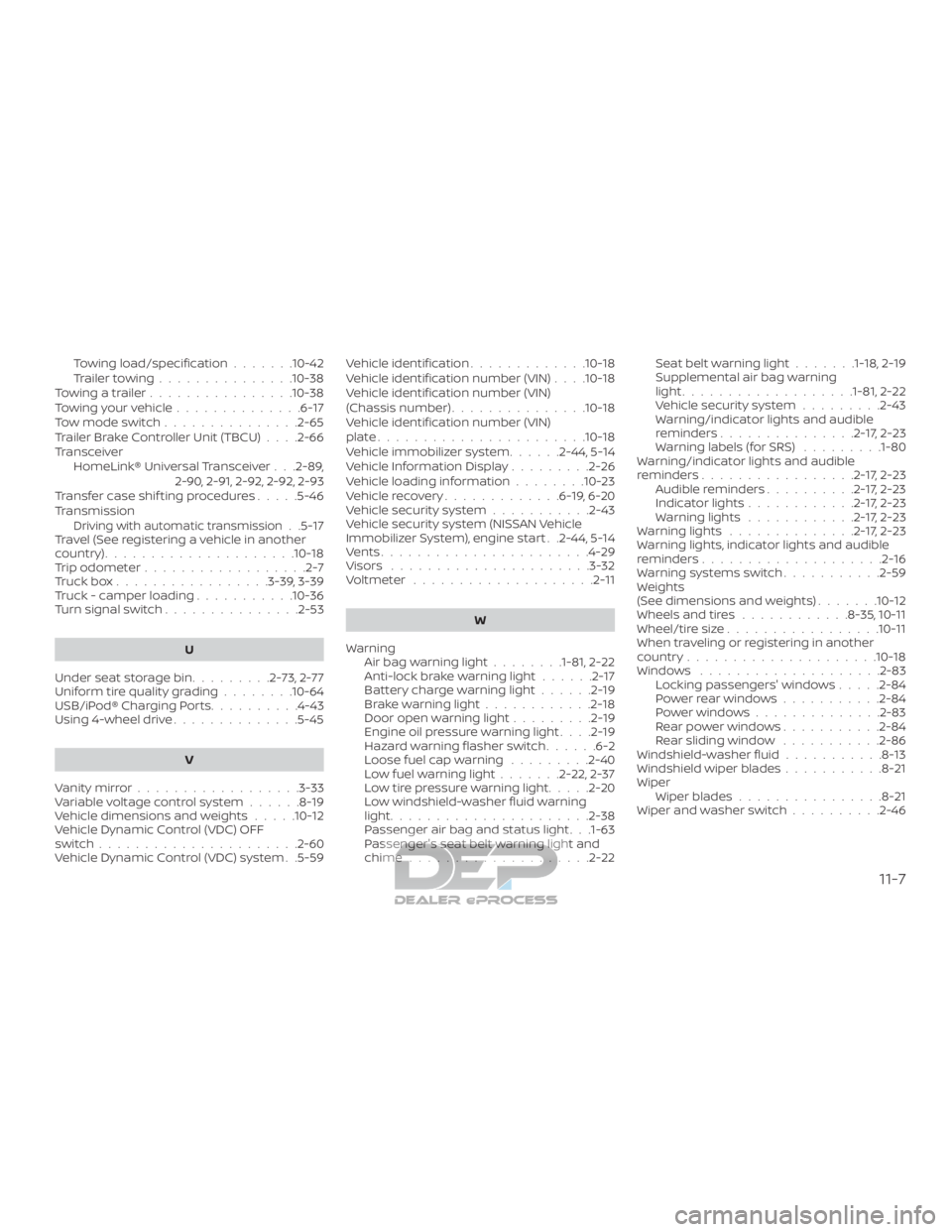
Towing load/specification.......10-42
Trailertowing...............10-38
Towingatrailer................10-38
Towingyourvehicle..............6-17
Tow mode switch ...............2-65
Trailer Brake Controller Unit (TBCU) ....2-66
Transceiver HomeLink® Universal Transceiver . . .2-89, 2-90, 2-91, 2-92, 2-92, 2-93
Transfer case shif ting procedures .....5-46
Transmission
Driving with automatic transmission. .5-17
Travel (See registering a vehicle in another
country) .....................10-18
Trip odometer ..................2-7
Truckbox.................3-39,3-39
Truck - camper loading ...........10-36
Turn signal switch ...............2-53
U
Under seat storage bin .........2-73,2-77
Uniform tire quality grading ........10-64
USB/iPod® Charging Ports..........4-43
Using 4-wheel drive ..............5-45
V
Vanitymirror..................3-33
Variable voltage control system ......8-19
Vehicle dimensions and weights .....10-12
Vehicle Dynamic Control (VDC) OFF
switch......................2-60
Vehicle Dynamic Control (VDC) system . .5-59 Vehicle identification
.............10-18
Vehicle identification number (VIN) . . . .10-18
Vehicle identification number (VIN)
(Chassis number) ...............10-18
Vehicle identification number (VIN)
plate.......................10-18
Vehicle immobilizer system ......2-44,5-14
VehicleInformationDisplay.........2-26
Vehicle loading information ........10-23
Vehiclerecovery.............6-19,6-20
Vehicle security system ...........2-43
Vehicle security system (NISSAN Vehicle
Immobilizer System), engine start . .2-44, 5-14
Vents.......................4-29
Visors ......................3-32
Voltmeter ....................2-11
W
Warning Airbagwarninglight........1-81, 2-22
Anti-lock brake warning light ......2-17
Battery charge warning light ......2-19
Brakewarninglight............2-18
Door open warning light .........2-19
Engine oil pressure warning light ....2-19
Hazard warning flasher switch ......6-2
Loose fuel cap warning .........2-40
Lowfuelwarninglight.......2-22,2-37
Lowtirepressurewarninglight.....2-20
Low windshield-washer fluid warning
light......................2-38
Passenger air bag and status light . . .1-63
Passenger's seat belt warning light and
chime....................2-22 Seatbeltwarninglight.......1-18, 2-19
Supplemental air bag warning
light...................1-81, 2-22
Vehicle security system
.........2-43
Warning/indicator lights and audible
reminders ...............2-17,2-23
Warning labels (for SRS) .........1-80
Warning/indicator lights and audible
reminders .................2-17,2-23
Audible reminders ..........2-17,2-23
Indicatorlights............2-17,2-23
Warninglights ............2-17,2-23
Warninglights ..............2-17,2-23
Warning lights, indicator lights and audible
reminders ....................2-16
Warningsystemsswitch...........2-59
Weights
(See dimensions and weights) .......10-12
Wheels and tires ............8-35,10-11
Wheel/tire size .................10-11
When traveling or registering in another
country .....................10-18
Windows ....................2-83 Locking passengers' windows .....2-84
Powerrearwindows...........2-84
Powerwindows..............2-83
Rearpowerwindows...........2-84
Rearslidingwindow ...........2-86
Windshield-washer fluid ...........8-13
Windshield wiper blades ...........8-21
Wiper Wiper blades ................8-21
Wiper and washer switch ..........2-46
11-7
Page 619 of 682
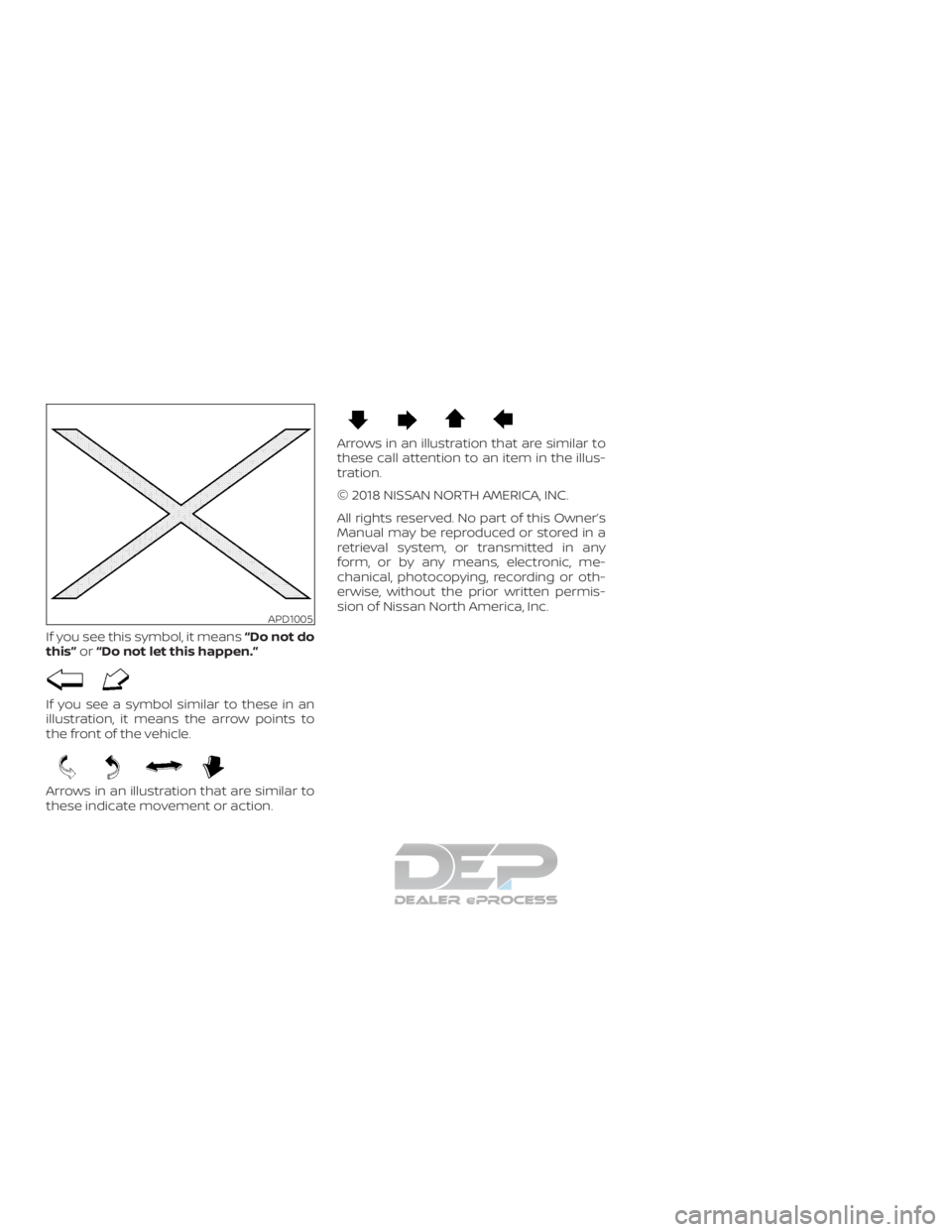
If you see this symbol, it means“Do not do
this” or“Do not let this happen.”
If you see a symbol similar to these in an
illustration, it means the arrow points to
the front of the vehicle.
Arrows in an illustration that are similar to
these indicate movement or action.
Arrows in an illustration that are similar to
these call attention to an item in the illus-
tration.
© 2018 NISSAN NORTH AMERICA, INC.
All rights reserved. No part of this Owner’s
Manual may be reproduced or stored in a
retrieval system, or transmitted in any
form, or by any means, electronic, me-
chanical, photocopying, recording or oth-
erwise, without the prior written permis-
sion of Nissan North America, Inc.
APD1005
Page 623 of 682
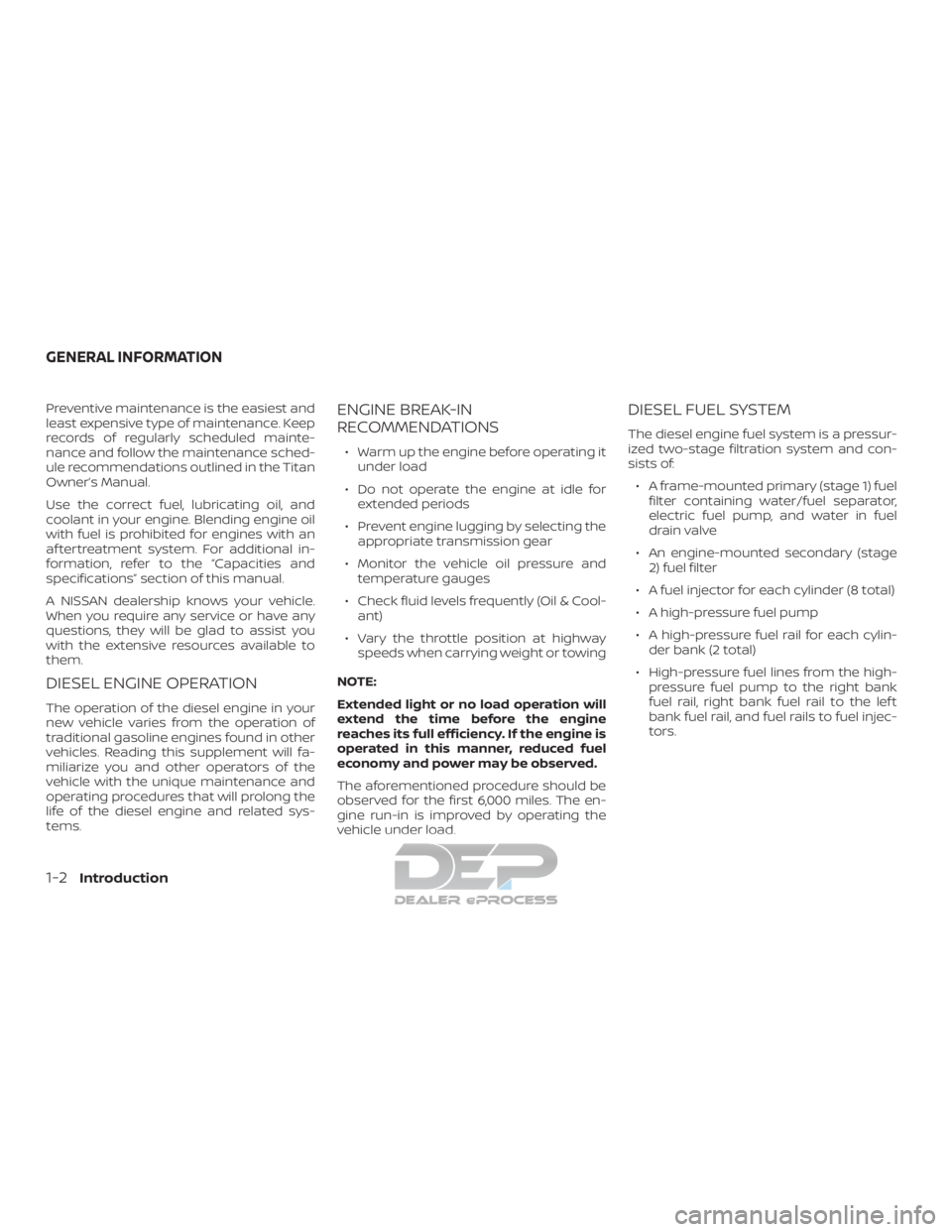
Preventive maintenance is the easiest and
least expensive type of maintenance. Keep
records of regularly scheduled mainte-
nance and follow the maintenance sched-
ule recommendations outlined in the Titan
Owner’s Manual.
Use the correct fuel, lubricating oil, and
coolant in your engine. Blending engine oil
with fuel is prohibited for engines with an
af tertreatment system. For additional in-
formation, refer to the “Capacities and
specifications” section of this manual.
A NISSAN dealership knows your vehicle.
When you require any service or have any
questions, they will be glad to assist you
with the extensive resources available to
them.
DIESEL ENGINE OPERATION
The operation of the diesel engine in your
new vehicle varies from the operation of
traditional gasoline engines found in other
vehicles. Reading this supplement will fa-
miliarize you and other operators of the
vehicle with the unique maintenance and
operating procedures that will prolong the
life of the diesel engine and related sys-
tems.
ENGINE BREAK-IN
RECOMMENDATIONS
∙ Warm up the engine before operating itunder load
∙ Do not operate the engine at idle for extended periods
∙ Prevent engine lugging by selecting the appropriate transmission gear
∙ Monitor the vehicle oil pressure and temperature gauges
∙ Check fluid levels frequently (Oil & Cool- ant)
∙ Vary the throttle position at highway speeds when carrying weight or towing
NOTE:
Extended light or no load operation will
extend the time before the engine
reaches its full efficiency. If the engine is
operated in this manner, reduced fuel
economy and power may be observed.
The aforementioned procedure should be
observed for the first 6,000 miles. The en-
gine run-in is improved by operating the
vehicle under load.
DIESEL FUEL SYSTEM
The diesel engine fuel system is a pressur-
ized two-stage filtration system and con-
sists of: ∙ A frame-mounted primary (stage 1) fuel filter containing water/fuel separator,
electric fuel pump, and water in fuel
drain valve
∙ An engine-mounted secondary (stage 2) fuel filter
∙ A fuel injector for each cylinder (8 total)
∙ A high-pressure fuel pump
∙ A high-pressure fuel rail for each cylin- der bank (2 total)
∙ High-pressure fuel lines from the high- pressure fuel pump to the right bank
fuel rail, right bank fuel rail to the lef t
bank fuel rail, and fuel rails to fuel injec-
tors.
GENERAL INFORMATION
1-2Introduction
Page 638 of 682
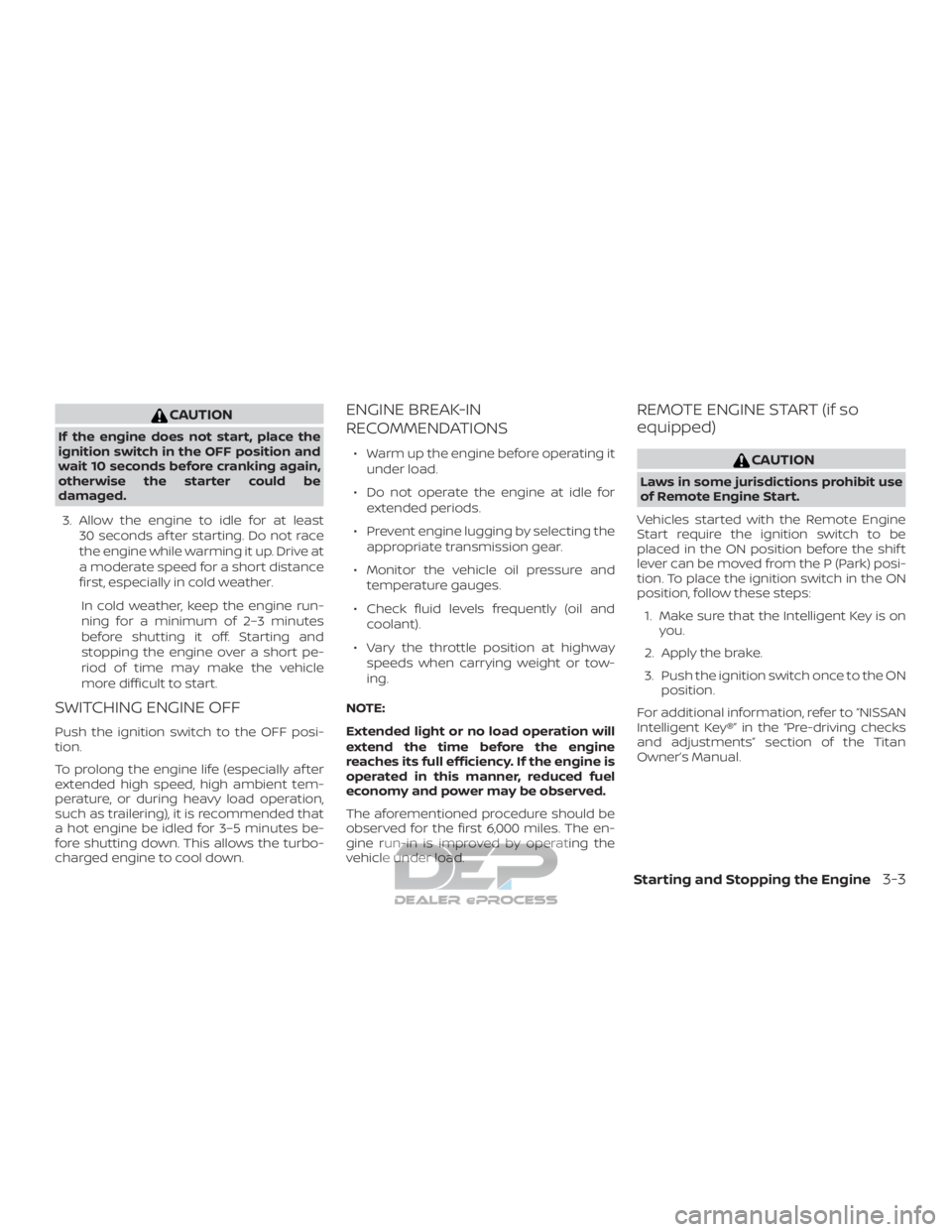
CAUTION
If the engine does not start, place the
ignition switch in the OFF position and
wait 10 seconds before cranking again,
otherwise the starter could be
damaged.3. Allow the engine to idle for at least 30 seconds af ter starting. Do not race
the engine while warming it up. Drive at
a moderate speed for a short distance
first, especially in cold weather.
In cold weather, keep the engine run-
ning for a minimum of 2–3 minutes
before shutting it off. Starting and
stopping the engine over a short pe-
riod of time may make the vehicle
more difficult to start.
SWITCHING ENGINE OFF
Push the ignition switch to the OFF posi-
tion.
To prolong the engine life (especially af ter
extended high speed, high ambient tem-
perature, or during heavy load operation,
such as trailering), it is recommended that
a hot engine be idled for 3–5 minutes be-
fore shutting down. This allows the turbo-
charged engine to cool down.
ENGINE BREAK-IN
RECOMMENDATIONS
∙ Warm up the engine before operating it under load.
∙ Do not operate the engine at idle for extended periods.
∙ Prevent engine lugging by selecting the appropriate transmission gear.
∙ Monitor the vehicle oil pressure and temperature gauges.
∙ Check fluid levels frequently (oil and coolant).
∙ Vary the throttle position at highway speeds when carrying weight or tow-
ing.
NOTE:
Extended light or no load operation will
extend the time before the engine
reaches its full efficiency. If the engine is
operated in this manner, reduced fuel
economy and power may be observed.
The aforementioned procedure should be
observed for the first 6,000 miles. The en-
gine run-in is improved by operating the
vehicle under load.
REMOTE ENGINE START (if so
equipped)
CAUTION
Laws in some jurisdictions prohibit use
of Remote Engine Start.
Vehicles started with the Remote Engine
Start require the ignition switch to be
placed in the ON position before the shif t
lever can be moved from the P (Park) posi-
tion. To place the ignition switch in the ON
position, follow these steps: 1. Make sure that the Intelligent Key is on you.
2. Apply the brake.
3. Push the ignition switch once to the ON position.
For additional information, refer to “NISSAN
Intelligent Key®” in the “Pre-driving checks
and adjustments” section of the Titan
Owner’s Manual.
Starting and Stopping the Engine3-3
Page 656 of 682
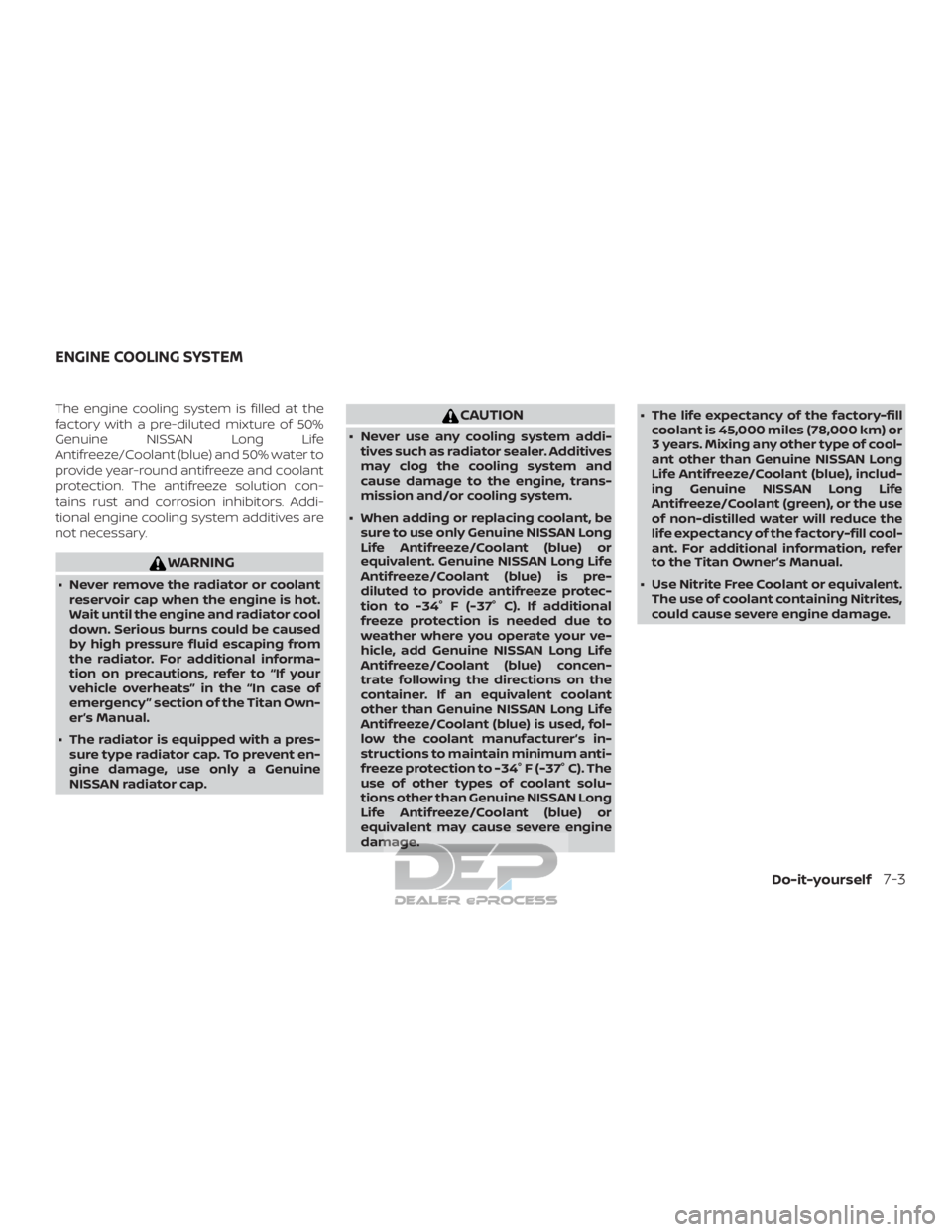
The engine cooling system is filled at the
factory with a pre-diluted mixture of 50%
Genuine NISSAN Long Life
Antifreeze/Coolant (blue) and 50% water to
provide year-round antifreeze and coolant
protection. The antifreeze solution con-
tains rust and corrosion inhibitors. Addi-
tional engine cooling system additives are
not necessary.
WARNING
∙ Never remove the radiator or coolantreservoir cap when the engine is hot.
Wait until the engine and radiator cool
down. Serious burns could be caused
by high pressure fluid escaping from
the radiator. For additional informa-
tion on precautions, refer to “If your
vehicle overheats” in the “In case of
emergency ” section of the Titan Own-
er’s Manual.
∙ The radiator is equipped with a pres- sure type radiator cap. To prevent en-
gine damage, use only a Genuine
NISSAN radiator cap.
CAUTION
∙ Never use any cooling system addi-tives such as radiator sealer. Additives
may clog the cooling system and
cause damage to the engine, trans-
mission and/or cooling system.
∙ When adding or replacing coolant, be sure to use only Genuine NISSAN Long
Life Antifreeze/Coolant (blue) or
equivalent. Genuine NISSAN Long Life
Antifreeze/Coolant (blue) is pre-
diluted to provide antifreeze protec-
tion to -34° F (-37° C). If additional
freeze protection is needed due to
weather where you operate your ve-
hicle, add Genuine NISSAN Long Life
Antifreeze/Coolant (blue) concen-
trate following the directions on the
container. If an equivalent coolant
other than Genuine NISSAN Long Life
Antifreeze/Coolant (blue) is used, fol-
low the coolant manufacturer’s in-
structions to maintain minimum anti-
freeze protection to -34° F (-37° C). The
use of other types of coolant solu-
tions other than Genuine NISSAN Long
Life Antifreeze/Coolant (blue) or
equivalent may cause severe engine
damage. ∙ The life expectancy of the factory-fill
coolant is 45,000 miles (78,000 km) or
3 years. Mixing any other type of cool-
ant other than Genuine NISSAN Long
Life Antifreeze/Coolant (blue), includ-
ing Genuine NISSAN Long Life
Antifreeze/Coolant (green), or the use
of non-distilled water will reduce the
life expectancy of the factory-fill cool-
ant. For additional information, refer
to the Titan Owner’s Manual.
∙ Use Nitrite Free Coolant or equivalent. The use of coolant containing Nitrites,
could cause severe engine damage.
ENGINE COOLING SYSTEM
Do-it-yourself7-3